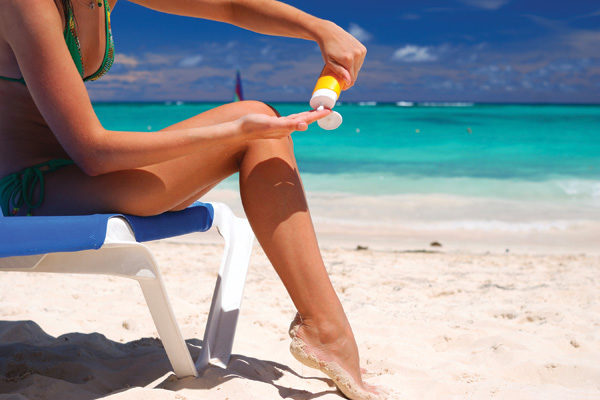Staying safe in the sun is a huge concern for anyone spending time outdoors. Whether your shoppers are lounging at the beach, working outside or just taking a stroll through the park, they are at risk for skin damage from the sun. Sunscreen is essential, but with so many on the market, it is difficult for consumers to know the differences and which to choose. Thankfully, there are numerous natural choices to keep skin safe from burns without coating it with harmful chemicals.
Traditional vs. Natural Sunscreens
Many traditional sunscreens have harmful levels of ingredients such as retinyl palmitate, a synthetic form of vitamin A. This component, found in approximately 41% of sunscreens, has been found to possibly speed the growth of skin lesions. In 2010, New York Senator Charles Schumer called on the U.S. Food and Drug Administration (FDA) to address the possible link between skin cancer and this chemical, since the agency had yet to issue a final assessment or guidance on it (1).
Another chemical, oxybenzone, is found in approximately 60% of sunscreens and is used to enhance the penetration of other chemicals used in these products. But, it has been shown to adversely affect the endocrine system, cause allergies and contribute to cellular damage (2). In pregnant women, it has even been linked to babies with low birth weight, says the Centers for Disease Control and Prevention (3). According to the Environmental Working Group (EWG) sunscreen guide, only 8% of all available sun-protection products are recommended, in part because the others include this and other harmful chemicals (2).
Shoppers can turn to natural sunscreens instead of  conventional products. None of the products recommended by the EWG guide are conventional sunscreens; they are all-natural and mineral-based products (1). Rather than using chemicals to absorb harmful rays, the active ingredients are titanium dioxide and zinc oxide. These minerals naturally work to physically block the sun’s rays. Other natural ingredients used in these sunscreens include beeswax, hemp seed oil and green tea extracts, among others (3).
conventional products. None of the products recommended by the EWG guide are conventional sunscreens; they are all-natural and mineral-based products (1). Rather than using chemicals to absorb harmful rays, the active ingredients are titanium dioxide and zinc oxide. These minerals naturally work to physically block the sun’s rays. Other natural ingredients used in these sunscreens include beeswax, hemp seed oil and green tea extracts, among others (3).
There is another practical reason to choose natural sunscreens over conventional products. Mainstream products are prepared to absorb UVB rays, which cause sunburns, and do not always fully guard against UVA rays, which cause skin aging and cancer. Mineral sunscreens are better equipped for protecting against both forms of damage, thus offering a more thorough protection (4).
Remind shoppers that no matter which product they choose, it is important to be consistent and liberal with their usage. Recommend that they use enough of these products to fill a shot glass, as well as taking the time to apply in advance and rub in thoroughly, as the natural products sometimes need extra time to be effective (3). Also, the Skin Cancer Foundation recommends reapplying sunscreen every two hours. Reapplying the product after swimming, toweling off or sweating heavily is also a good idea, even if the product is labeled “water resistant” (4). Warn consumers to be cautious with their time in the sun and always use some kind of protection.
Getting a Golden Tan the Safe Way
In addition to catering to the sun-cautious consumer, it is equally if not more important to approach clients who are unafraid of spending hours lying in the sun. Many people, especially teenagers, are unconcerned about the toll the sun takes on their skin as long as they achieve a golden tan. According to Darius Karimipour, M.D., a dermatologist and clinical assistant professor in the University of Michigan Health System’s department of Dermatology, approximately 80% of sun exposure and damage occurs before the age of 18, making the teenage market important to target with skin-protecting products (5).
For teens interested in tanning, offer natural self-tanners as a safer alternative to baking in the sun or in a tanning bed. The active ingredient in most tanning lotions and creams is dihydroxyacetone (DHA), which is a sugar taken from plants that stains the skin darker (6). It is temporary, so the stain will eventually fade, but is not as damaging as prolonged sun exposure.
Even with natural sunscreens, there are ingredients of which to be wary. These products may say “natural” on the label, but contain ingredients that true organic/natural companies won’t touch. When recommending self-tanners, choose those without parabens, which are preservatives that can affect the endocrine system. Also steer clear of products using 1,4 Dioxane, which has been shown to cause cancer in animals (7).
There are numerous beneficial ingredients employed in natural self-tanners. Aloe vera and chamomile are used to soothe the skin. Almond, sesame and avocado oils moisturize, as well as walnut shell extract and green tea (7). With a wide variety of natural sunscreens and self-tanners, sun-lovers can still be safe while enjoying their time outside. WF
References
1. “Schumer Reveals: Evidence Mounting That Suggests Possible Link Between Chemical Found In Most Sunscreens and Skin Cancer,” press release distributed June 14, 2010, http://schumer.senate.gov/new_website
/record.cfm?id=325644, accessed Mar. 11, 2011.
2. WholeFoods Magazine, “EWG Releases 2010 Sunscreen Guide,” www.wholefoodsmagazine.com/news/breaking-news/ewg-releases-2010-sunscreen-guide, published July 21, 2010, accessed Mar. 11, 2011.
3. S. Carpenter, “’Natural’ Sunscreen: Better for You?” www.latimes.com/features/image/la-ig-naturalsunscreen-20100627,0,6048986.story, Los Angeles Times, June 27, 2010, accessed Mar. 11, 2011.
4. Green Guide for Everyday Living, “Sunscreen Buying Guide,” http://environment.nationalgeographic.com/environment/green-guide, accessed Mar. 11, 2011.
5. ScienceDaily, “Are Teens Dying for a Tan?” www.sciencedaily.com/releases/2004/02/040227074434.htm, University Of Michigan Health System, press release distributed Mar. 1, 2004, accessed Mar. 11, 2011.
6. Natural Living for Women, “Going for a Natural Looking Sunless Tan?” www.natural-living-for-women.com/sunless-tan.html, accessed Mar. 11, 2011.
7. GreenYour, “Choose a Natural Self Tanner,” www.greenyour.com/body/personal-care/sun-care/tips/choose-a-natural-self-tanner, accessed Mar. 11, 2011.
Meghan Coates is a freelance writer based in Clinton, NJ.









